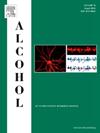受惩罚的酒精自我管理的个体差异不受酒精蒸气暴露的影响。
IF 2.9
4区 医学
Q3 PHARMACOLOGY & PHARMACY
引用次数: 0
摘要
不顾不良后果继续饮酒是酒精使用障碍(AUD)的一个显著特征。人们对不顾负面后果饮酒的个体差异是由于固有差异还是在长期饮酒后出现的这一问题仍然知之甚少。本研究的目的是利用雄性 Wistar 大鼠不顾负面后果饮酒的模型来评估酒精蒸汽暴露前后脚部休克惩罚性酒精自我给药的个体差异。在建立了基线操作性自我给药后,大鼠接受了额外的自我给药训练,其中引入了随机的、与反应相关的脚震惩罚。计算每只大鼠在惩罚过程中与基线相比的平均变化百分比,并使用上下三分之二将大鼠分为电击敏感(SS)和电击耐受(SR)亚组。然后,每隔一周对大鼠进行 3 个周期的空气或酒精蒸汽暴露,并在中间的几周内进行不受惩罚的自我给药。在最后一个水蒸气周期之后,重新评估大鼠在受惩罚的自我给药过程中对脚部冲击的抵抗力。总体而言,酒精蒸汽暴露对惩罚性自我管理没有影响,对不同亚组也没有影响。对个体差异的研究表明,无论在空气还是蒸汽条件下,被归类为 SR 的大鼠在未受惩罚的自我管理方面都比基线时有所提高。这些数据表明,酒精史对脚电击惩罚性自我管理的个体差异影响很小。本文章由计算机程序翻译,如有差异,请以英文原文为准。
Individual differences in punished alcohol self-administration are unaltered by alcohol vapor exposure
Continued alcohol use despite negative consequences is a defining feature of alcohol use disorder (AUD). It remains poorly understood whether individual variability in drinking despite negative consequences is due to inherent differences or emerges after prolonged alcohol use. The goal of the present study was to use a rat model of drinking despite negative consequences to assess individual differences in foot shock-punished alcohol self-administration prior to and following alcohol vapor exposure in male Wistar rats. After baseline operant self-administration was established, rats underwent additional self-administration sessions in which random, response-contingent foot shock punishment was introduced. Average percent change from baseline was calculated for each rat during punished sessions and rats were classified into shock-sensitive (SS) and shock-resistant (SR) subgroups using the top and bottom thirds. Rats then underwent 3 cycles of air or alcohol vapor exposure every other week, with unpunished self-administration sessions occurring during the intervening weeks. Following the last vapor cycle, rats were re-assessed for resistance to foot shock during punished self-administration sessions. Alcohol vapor exposure had no effect on punished self-administration overall, nor by subgroup. Examination of individual differences showed that rats classified as SR showed increased unpunished self-administration relative to baseline regardless of air vs. vapor condition. These data suggest that alcohol history has a minimal effect on individual differences in foot shock-punished self-administration.
求助全文
通过发布文献求助,成功后即可免费获取论文全文。
去求助
来源期刊

Alcohol
医学-毒理学
CiteScore
4.60
自引率
4.30%
发文量
74
审稿时长
15.6 weeks
期刊介绍:
Alcohol is an international, peer-reviewed journal that is devoted to publishing multi-disciplinary biomedical research on all aspects of the actions or effects of alcohol on the nervous system or on other organ systems. Emphasis is given to studies into the causes and consequences of alcohol abuse and alcoholism, and biomedical aspects of diagnosis, etiology, treatment or prevention of alcohol-related health effects.
Intended for both research scientists and practicing clinicians, the journal publishes original research on the neurobiological, neurobehavioral, and pathophysiological processes associated with alcohol drinking, alcohol abuse, alcohol-seeking behavior, tolerance, dependence, withdrawal, protracted abstinence, and relapse. In addition, the journal reports studies on the effects alcohol on brain mechanisms of neuroplasticity over the life span, biological factors associated with adolescent alcohol abuse, pharmacotherapeutic strategies in the treatment of alcoholism, biological and biochemical markers of alcohol abuse and alcoholism, pathological effects of uncontrolled drinking, biomedical and molecular factors in the effects on liver, immune system, and other organ systems, and biomedical aspects of fetal alcohol spectrum disorder including mechanisms of damage, diagnosis and early detection, treatment, and prevention. Articles are published from all levels of biomedical inquiry, including the following: molecular and cellular studies of alcohol''s actions in vitro and in vivo; animal model studies of genetic, pharmacological, behavioral, developmental or pathophysiological aspects of alcohol; human studies of genetic, behavioral, cognitive, neuroimaging, or pathological aspects of alcohol drinking; clinical studies of diagnosis (including dual diagnosis), treatment, prevention, and epidemiology. The journal will publish 9 issues per year; the accepted abbreviation for Alcohol for bibliographic citation is Alcohol.
 求助内容:
求助内容: 应助结果提醒方式:
应助结果提醒方式:


